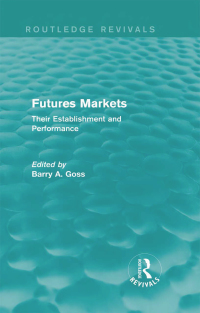Question
Your project is to prepare a financial analysis . This takes a close look at two corporations, Bayer and Monsanto. Bayer is considering a bid
Your project is to prepare a financial analysis. This takes a close look at two corporations, Bayer and Monsanto. Bayer is considering a bid for United States seed company Monsanto (Snider, 2016). For purposes of this project, you will act as the Chief Financial Officer of Monsanto Corporation, analyzing financial documents and determining whether Monsanto should indeed go forward with acceptance of the purchase.
Bayer is a life science firm with a more than 150-year history and core competencies in the areas of healthcare and agriculture. With its innovative products, it contributes to finding solutions major challenges, such as a growing and aging world population requiring improved medical care and an adequate supply of food. Bayer addresses these issues by preventing, alleviating and treating diseases, and helping to provide a reliable supply of high-quality food, feed and plant-based raw materials. Bayer Pharmaceutical is Bayers largest division in terms of total sales. This division focuses on researching, developing and marketing innovative medicines with a positive cost-benefit ratio primarily in the therapeutic areas of cardiology, oncology, gynecology, hematology and ophthalmology. To safeguard long-term growth, Bayer is currently seeking increase its investment in research and development. Besides expanding early research, Bayer is concentrating on the clinical development of active drug substance candidates in the therapeutic areas of cardiology, oncology, hematology and gynecology. In addition, it is selectively expanding and supplementing its development portfolio through licensing agreements and acquisitions. The Crop Science Division of Bayer, on the other hand, focuses on improvement in agricultural sustainability, crop yields and quality, as well as the leveraging of digitization to help make products safer (Bayer, 2016). Bayers aim is to help shape the future of the agricultural industry with innovative offerings that increase its productivity, thus generating profitable and sustainable growth for Crop Science and its customers and enabling the production of sufficient food, animal feed and renewable raw materials for a growing world population despite the limited amount of available arable land. This strategy is complementary to its Animal Science Division, which produces animal feed products. Bayer Crop Science Divisions current strategy is to enhance its Crop Protection and Environmental Science portfolio, expand its Seeds business, and to lead the way in innovation and develop holistic solution (Bayer AG, 2016). For purposes of this discussion, assume that Bayer aims to build on its expertise in the integration of seed technology with chemical and biological crop protection.
For purposes of this project, assume that Bayer is seeking to acquire Monsanto Corporation. Monsanto, along with its subsidiaries, is a leading global provider of agricultural products for farmers. Through its seeds, biotechnology-trait products, herbicides and precision agriculture tools, Monsanto (Monsanto, 2016) seeks to provide farmers with solutions that help improve productivity, reduce the costs of farming and produce better foods for consumers and better feed for animals. Monsanto has a worldwide distribution, sales and marketing organization for its agricultural-productivity products. In a growing number of locations throughout the world, it produces directly or contracts with third-party growers for corn seed, soybean, vegetable, cotton, canola and other seeds. The global market for its Seeds and Genomics segment is increasingly competitive. Both its row crops and its vegetable seed businesses compete with numerous multinational agrichemical and seed marketers globally, and with hundreds of smaller companies regionally.
Bayers proposal would pair Monsanto, the world's largest seed company, with drug-maker Bayer's growing seed and crop protection portfolio. Upon announcement of the possibility of such a bid, shares of St. Louis-based Monsanto (MON) rose by 8.7% (Kirchfield, et. al., 2016). Across 2015, immediately following announcement of a possible merger between the two firms, Bayer's growing agribusiness division saw sales rise 9% to $11.8 billion, while its healthcare sales rose 19% to $26 billion, as market participants reacted to news of the possible merger. Overall, Bayer's 2015 sales rose 12%, to $52.8 billion (Business Wire, 2014). On the other hand, Monsanto, which makes seeds (corn, cotton, fruits and other vegetables) and crop protection chemicals such as RoundUp, reported sales of $15 billion in its 2015 fiscal year. This was a 5% decline from the previous year (Daily Management Review, 2016). See Table 1, below, for an alternative view of these results.
Prompt:
In this project, you will assume that Bayer is considering a bid for United States seed company Monsanto (Snider, 2016). For purposes of this project, assume that you are Chief Financial Officer of Monsanto Corporation. Bayers proposal would pair Monsanto, the world's largest seed company, with drug maker Bayer's growing seed and crop protection portfolio. Upon announcement of the possibility of such a bid, shares of St. Louis-based Monsanto (MON) rose by 8.7% (Kirchfield, et. al., 2016). Across 2015, immediately following announcement of a possible merger between the two firms, Bayer's growing agribusiness division saw sales rise 9% to $11.8 billion, while its healthcare sales rose 19% to $26 billion. Overall, Bayer's 2015 sales rose 12%, to $52.8 billion (Business Wire, 2014). On the other hand, Monsanto, which makes seeds (corn, cotton, fruits and other vegetables) and crop protection chemicals such as RoundUp, reported sales of $15 billion in its 2015 fiscal year. This was a 5% decline from the previous year (Daily Management Review, 2016). Assume that Monsanto is taxed (TC) at a rate of 35% and its cost of debt (RD) is 12%. See Table 1, below, for an alternative view of this data. In the context of Bayers proposal, assume that Bayers Beta is 1.24. For purposes of valuation of cash flows in the context of Bayers proposal, consider Monsantos discounted cash flow for only the upcoming 1 year of sales, and assume that Monsanto is expected to grow at a rate of 3% in the current year. Assume also that Monsantos current sales are projected to be $15,239,000, while its equity holdings are estimated to be $9,141,333 and its debt is $12,359,333. Assume that Monsantos Profit Margins and Total Asset Turnover are unchanged from 2015 levels. EBIT, depreciation, capital spending, and the change in net working capital will grow at the same rate as sales, which is expected to grow at a rate of 3% across this year, while capital investment will remain stable
As an alternative proposal means of increasing shareholder value, as Chief Financial Officer of Monsanto, you have also been asked to evaluate a management proposal to expand Monsantos existing operations to pesticide production, yielding an increase in sales of $3,950,000. In the context of this alternative proposal, assume that there is no excess capacity, and the increase in fixed asset needs would be equal to 70% of this increase in sales, while cost of sales would run 20% of sales, using a percentage of sales approach. Also assume that Monsanto issues dividends at a rate of 1.98% of net sales, and thus the firms retention ratio is 98.2%. Assume that Monsantos current total level of sales is $15,239,000, while the division involved in this project is expected to yield sales of $2,950,000 in the current year. Assume that the proposed project has a risk and weighted average cost of capital similar to that of Monsanto, and a firm beta similar to that of Monsanto.
Upon receipt of Bayers proposal, your companys Board of Directors has directed you, as Chief Financial Officer of Monsanto Corporation, to review key statistics and other information and report to the Board on the following:
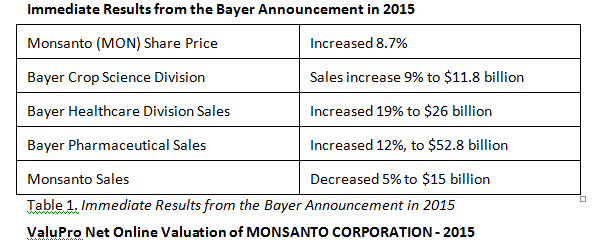
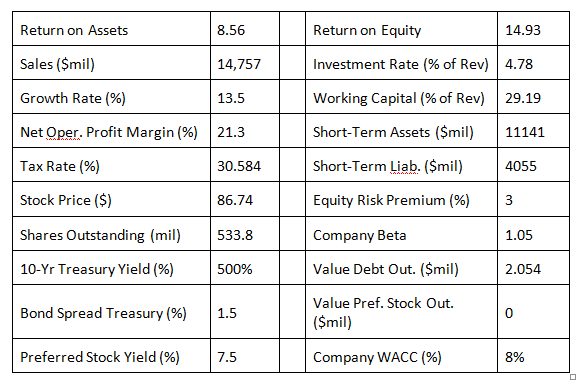
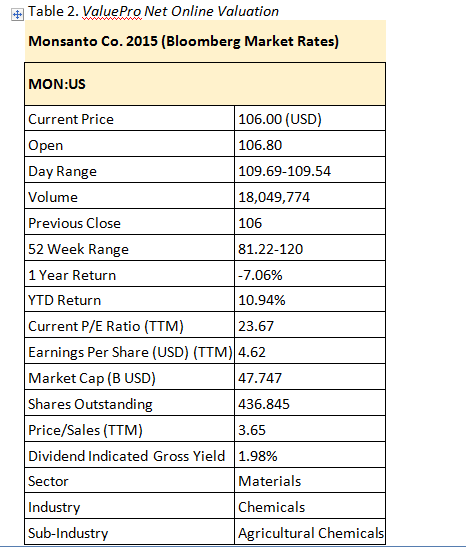
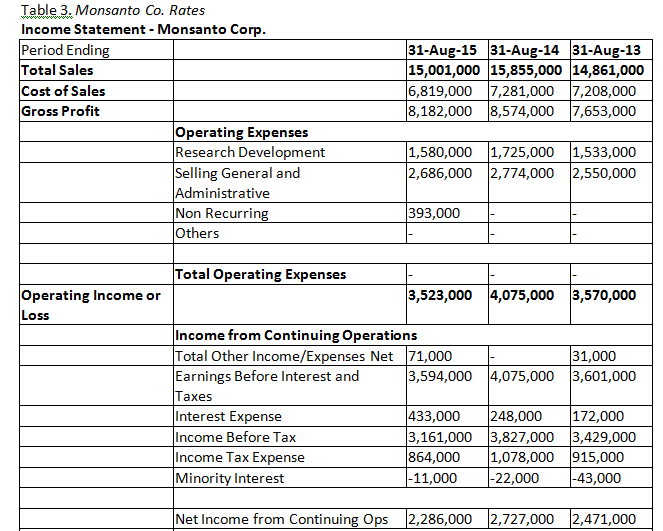
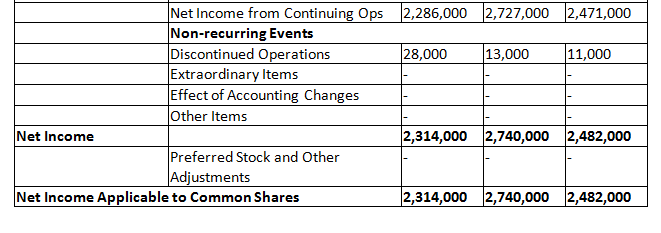


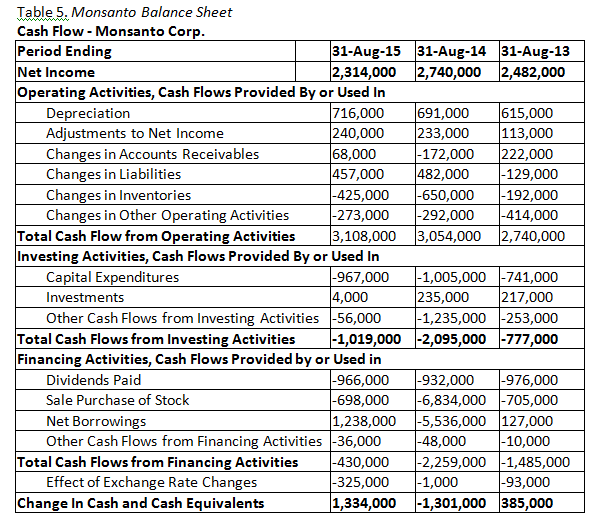
Requirement:
1. Taking account of background information and other information supplied here, determine whether to accept or reject this proposal for $62B. For purposes of this analysis, consider discounted adjusted cash flow for only the current year, in which the firm is anticipated to grow at a rate of 3%. Evaluate each of the following:
a)From given information
i) Ascertain Monsantos weighted average cost of capital (WACC) and use this along with the firms growth rate to determine the discounted value of adjusted cash flows. Employ the discounted value of adjusted cash flows to determine how this offer compares to the present value of the firms adjusted cash flow (CFA*), using the firms WACC.
ii) Explain the importance that this has for the firm, and for shareholders, noting that this is an issue which you have not covered in previous Milestones - and thus you will use this additional measure alongside measures prepared in Milestone One, as you complete Milestone Three. Use information from all assigned readings to support your analyses.
b) Justify your decision to accept or reject this offer using additional evidence drawn from ratio analysis, financial statement analysis, or time and trend analysis, refining your Milestone One analyses as applicable, given information covered in subsequent modules, and given current sales, equity and debt information included here.
2. With respect to the firms alternative proposal, determine:
a) The extent to which Monsanto will have to take on additional debt, given that it wishes to retain its current dividend ratio and does not wish to sell additional equities.
b) Calculate the firms sustainable growth rate and internal growth rate and use these measures to analyze a decision to accept this alternative proposal. Use these measures and concepts covered in assigned readings including EFN, DuPont Identity and leverage, Modules One through Eight, to explain the importance of these measures to shareholder interests.
Immediate Results from the Bayer Announcement in 2015 Monsanto (MON) Share Price Bayer Crop Science Division Bayer Healthcare Division Sales Bayer Pharmaceutical Sales Monsanto Sales Table 1Imediate Results from the Bayer Announcement in 2015 ValuPro Net Online Valuation of MONSANTO CORPORATION- 2015 increased 8.7% Sales increase 9% to $11.8 billion increased 19% to $26 billion increased 12%, to $52.8 billion Decreased 5% to $15 billion 8.56 14,757 13.5 Return on Assets Sales (Smil) Growth Rate (%) Net Oper. Profit Margin (%) 21.3 Tax Rate (%) Stock Price ($) Shares Outstanding (mil)533 10-Yr Treasury Yield (%) Bond Spread Treasury (%) 11.5 Preferred Stock Yield (%) 17.5 Return on Equity Investment Rate (% of Rev) | 4.78 Working Capital (% of Rev) | 29.19 Short-Term Assets (Smil 11141 Short-Term Liab. (Smil) Equity Risk Premium (%) Company Beta Value Debt Out. (Smil) Value Pref. Stock Out. (Smil) Company WACC (%) 14.93 30.584 86.74 8 500% 4055 1.05 2.054 0 8% Table 2. ValuePro Net Online Valuation Monsanto Co. 2015 (Bloomberg Market Rates) MON:US Current Price Open Day Range Volume Previous Close 52 Week Range 1 Year Return YTD Return Current P/E Ratio (TTM) Earnings Per Share (USD) (TTM) 4.62 Market Cap (B USD) Shares Outstanding Price/Sales (TTM) Dividend indicated Gross Yield 1.98% Sector Industry Sub-Industry 106.00 (USD) 106.80 109.69-109.54 18,049,774 106 81.22-120 10.94% 23.67 47.747 436.845 3.65 Materials Chemicals Agricultural Chemicals Table 3 Monsanto Co. Rates Income Statement - Monsanto Corp Period Endin Total Sales Cost of Sales Gross Profit 31-Aug-1531-Aug-14 31-Aug-13 15,001,000 15,855,000 14,861,000 6,819,000 7,281,0007,208,000 8,182,000 8,574,0007,653,000 Operating Expenses Research Development Selling General and Administrative Non Recurrin Others 1,580,000 1,725,000 1,533,000 2,686,000 2,774,000 2,550,000 393,000 Total Operating Expenses Operating Income or Loss 3,523,000 4,075,000 3,570,000 Income from Continuing Operations otal Other Income/Expenses Net Earnings Before Interest and 71,000 3,594,000 4,075,000 3,601,000 31,000 axes Interest Expense Income Before Tax Income Tax Expense Minority Interest 433,000 248,000 3,161,000 3,827,0003,429,000 864,000 1,078,000915,000 11,000 172,000 22,000 43,000 Net Income from Continuing Ops 2,286,000 2,727,0002,471,000 2,727,000 2,471,000 Net Income from Continuing Ops Non-recurring Events Discontinued Operations Extraordinary ltems Effect of Accounting Changes Other Items 2,286,000 28,000 13,000 11,000 Net Income 2,314,000 2,740,000 2,482,000 Preferred Stock and Other Adjustments 2,314,000 2,740,000 2482,000 Net Income Applicable to Common Shares Liabilities Current Liabilities Accounts Payable Short/Current Long Term Debt Other Current Liabilities 3,950,000 4,359,000 3,756,000 687,000 540,000 14,930,000 14,043,0008,105,000 315,000 438,000 63,000 517,000 Total Liabilities Stockholders' Equity Misc. Stocks Options Warrants Redeemable Preferred Stock Preferred Stock Common Stock Retained Earnings Treasury Stock 6,000 10,374,000 9,012,000 7,188,000 6,000 6,000 140,000 12,053,000 10,032,000 11,464,000 10,003,000 10,783,000 2,801,000 1,114,000 -1,278,000 6,990,000 7,875,000 12,559,000 Capital Surplus Other Stockholder Equi Total Stockholder Equity Net Tangible Assets 1,597,000 2,002,000 7,813,000 Immediate Results from the Bayer Announcement in 2015 Monsanto (MON) Share Price Bayer Crop Science Division Bayer Healthcare Division Sales Bayer Pharmaceutical Sales Monsanto Sales Table 1Imediate Results from the Bayer Announcement in 2015 ValuPro Net Online Valuation of MONSANTO CORPORATION- 2015 increased 8.7% Sales increase 9% to $11.8 billion increased 19% to $26 billion increased 12%, to $52.8 billion Decreased 5% to $15 billion 8.56 14,757 13.5 Return on Assets Sales (Smil) Growth Rate (%) Net Oper. Profit Margin (%) 21.3 Tax Rate (%) Stock Price ($) Shares Outstanding (mil)533 10-Yr Treasury Yield (%) Bond Spread Treasury (%) 11.5 Preferred Stock Yield (%) 17.5 Return on Equity Investment Rate (% of Rev) | 4.78 Working Capital (% of Rev) | 29.19 Short-Term Assets (Smil 11141 Short-Term Liab. (Smil) Equity Risk Premium (%) Company Beta Value Debt Out. (Smil) Value Pref. Stock Out. (Smil) Company WACC (%) 14.93 30.584 86.74 8 500% 4055 1.05 2.054 0 8% Table 2. ValuePro Net Online Valuation Monsanto Co. 2015 (Bloomberg Market Rates) MON:US Current Price Open Day Range Volume Previous Close 52 Week Range 1 Year Return YTD Return Current P/E Ratio (TTM) Earnings Per Share (USD) (TTM) 4.62 Market Cap (B USD) Shares Outstanding Price/Sales (TTM) Dividend indicated Gross Yield 1.98% Sector Industry Sub-Industry 106.00 (USD) 106.80 109.69-109.54 18,049,774 106 81.22-120 10.94% 23.67 47.747 436.845 3.65 Materials Chemicals Agricultural Chemicals Table 3 Monsanto Co. Rates Income Statement - Monsanto Corp Period Endin Total Sales Cost of Sales Gross Profit 31-Aug-1531-Aug-14 31-Aug-13 15,001,000 15,855,000 14,861,000 6,819,000 7,281,0007,208,000 8,182,000 8,574,0007,653,000 Operating Expenses Research Development Selling General and Administrative Non Recurrin Others 1,580,000 1,725,000 1,533,000 2,686,000 2,774,000 2,550,000 393,000 Total Operating Expenses Operating Income or Loss 3,523,000 4,075,000 3,570,000 Income from Continuing Operations otal Other Income/Expenses Net Earnings Before Interest and 71,000 3,594,000 4,075,000 3,601,000 31,000 axes Interest Expense Income Before Tax Income Tax Expense Minority Interest 433,000 248,000 3,161,000 3,827,0003,429,000 864,000 1,078,000915,000 11,000 172,000 22,000 43,000 Net Income from Continuing Ops 2,286,000 2,727,0002,471,000 2,727,000 2,471,000 Net Income from Continuing Ops Non-recurring Events Discontinued Operations Extraordinary ltems Effect of Accounting Changes Other Items 2,286,000 28,000 13,000 11,000 Net Income 2,314,000 2,740,000 2,482,000 Preferred Stock and Other Adjustments 2,314,000 2,740,000 2482,000 Net Income Applicable to Common Shares Liabilities Current Liabilities Accounts Payable Short/Current Long Term Debt Other Current Liabilities 3,950,000 4,359,000 3,756,000 687,000 540,000 14,930,000 14,043,0008,105,000 315,000 438,000 63,000 517,000 Total Liabilities Stockholders' Equity Misc. Stocks Options Warrants Redeemable Preferred Stock Preferred Stock Common Stock Retained Earnings Treasury Stock 6,000 10,374,000 9,012,000 7,188,000 6,000 6,000 140,000 12,053,000 10,032,000 11,464,000 10,003,000 10,783,000 2,801,000 1,114,000 -1,278,000 6,990,000 7,875,000 12,559,000 Capital Surplus Other Stockholder Equi Total Stockholder Equity Net Tangible Assets 1,597,000 2,002,000 7,813,000Step by Step Solution
There are 3 Steps involved in it
Step: 1

Get Instant Access to Expert-Tailored Solutions
See step-by-step solutions with expert insights and AI powered tools for academic success
Step: 2

Step: 3

Ace Your Homework with AI
Get the answers you need in no time with our AI-driven, step-by-step assistance
Get Started


